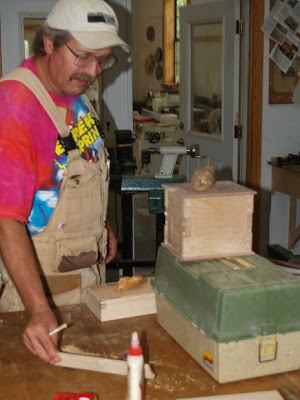

Joe has been using driftwood to make interesting pulls for his. The other photo shows drilling the holes for small dowels to lock the corners of finger-jointed boxes.
This blog is dedicated to sharing the concept that our hands are essential to learning- that we engage the world and its wonders, sensing and creating primarily through the agency of our hands. We abandon our children to education in boredom and intellectual escapism by failing to engage their hands in learning and making.
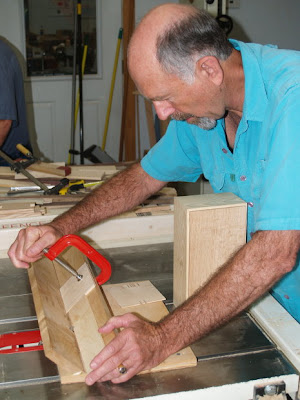
For more empirical support I can point to the burgeoning science of neurotheology. Its major premise is that the human impulse to practice religion—most specifically, the urge to enjoy mystical unitary states of oneness with the larger cosmos—-is rooted in the basic biology of the human brain. A key stimulant to achieving such states, according to some experts, is repetitive physical rhythms that block neural flow to certain important orientation areas of the brain and so dislodge egoistic notions of self. This explains, so the theory goes, the emphasis on ecstatic rhythmic dances found in various primitive religions and more subtle forms of rhythmic prayer and chanting found in more-sophisticated religions. It also explains commonplace soothing and/or ecstatic rhythmic experiences, such as the rocking of babies and the cheering of rabid fans at major sports events.


 But the ammonia wasn't the only fun I had with the hinges. I beat on them first with a waffle faced framing hammer. The results are much more interesting than what you see in the package.
But the ammonia wasn't the only fun I had with the hinges. I beat on them first with a waffle faced framing hammer. The results are much more interesting than what you see in the package.
...It was still a handcrafted world. There was an artisan quality to the population as well as the economic base: People, like things, were unique and distinctive, created one at a time, knowable as discrete entities. That would change, of course. As the population soared throughout the nineteenth century, and as products increasingly were made on assembly lines in factories, rather than by hand in barns and backyards, people and things became ubiquitous. They could be dealt with only in the aggregate. The land of the second chance would give way to a country of interchangeable parts, interchangeable people.I happen to live in a small community that could be considered to have "an artisan quality." We have more artists and craftspeople than bankers, lawyers, insurance agents combined. Many of our professionals combine careers in the normal world with avocations in the arts. So what Ms. Keller describes can still be if we exercise our wisdom in the use of our time and resources. If we were to spend less money and time attempting to discover our identities in the acquisition of objects and spent time and money instead in the making of things expressing creativity, care, beauty and love, we would not only transform ourselves as creators rather than consumers, we would transform our society as well.








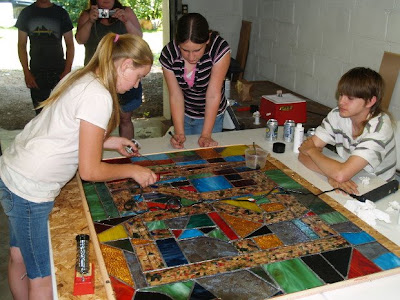






 I had my students doing measuring using exact feel of dimensions and using story sticks for tool set up and referencing left and right. While Dave is blind, most of us as we age lose some of our visual acuity and the sense of feel becomes of interest to us all in maintaining a desired level of precision. Thank you Dave for your inspiration.
I had my students doing measuring using exact feel of dimensions and using story sticks for tool set up and referencing left and right. While Dave is blind, most of us as we age lose some of our visual acuity and the sense of feel becomes of interest to us all in maintaining a desired level of precision. Thank you Dave for your inspiration.
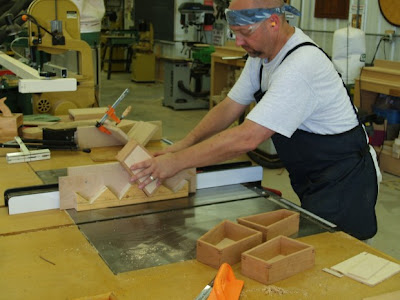 I love having the opportunity to share what I have learned with others, and of course some things, or maybe most things are learned most throughly from our mistakes. For instance, one student's box wasn't pushed tightly together at the joints before the glue set. No amount of clamping pressure would move the parts into the right position. So I suggested the microwave in Susie's kitchen. After 35 seconds the student reapplied the clamps, the parts moved into perfect place, and the box will be great for the next 100 years or more. Did I say already that I had a great day?
I love having the opportunity to share what I have learned with others, and of course some things, or maybe most things are learned most throughly from our mistakes. For instance, one student's box wasn't pushed tightly together at the joints before the glue set. No amount of clamping pressure would move the parts into the right position. So I suggested the microwave in Susie's kitchen. After 35 seconds the student reapplied the clamps, the parts moved into perfect place, and the box will be great for the next 100 years or more. Did I say already that I had a great day?
What a block 44th Street is in Manhattan! The Harvard Club, The Algonquin Hotel…. and right across the street at 27 W 44th Street there is a building you would pass by, not because the architecture is not eye-catching but because it is the building that houses the apparently “low brow,” General Society for Mechanics and Trades People – Technical School and Library . It is ironic that these entities are on opposite sides of the street or is it? Why are the Harvard Club and the Algonquin across the street? What really was the thinking of putting these organizations so close together? Two are the bastions of meetings where the word is the order of business and then we have an organization with the motto – “By Hammer and Hand All Arts Do Stand.” On our way to meet my old friend Richie, Damian and I walked into this place and took a tour. To our amazement, it was a beautiful old small school with great stained glass and lots of art of people engaged in making things. Like the clubs across the street, it was still active. After I got home, I did a bit of research and found out that a free day school was established in 1820 “to provide free education for the children of the members of the Society and such other children whose parents were unable to pay.” Over 180,000 students have passed through the doors of this small school and to this day they graduate students for 2 and 3-year technical degrees in everything from plumbing to electrical to construction management all tuition free. This year their graduating class was 44 students. Not bad for sustainability and getting people from one place in life to another. Now the kicker, this school and its library were funded by Andrew Carnegie and other New Yorkers who from their own beginnings knew the power of working with your hands as well as understanding that the future of a great city hinged on the education and inventions of their young people. The takeaway is that they knew how important know-how was and perhaps choosing this location was leaving a message that the word better pay attention to the deed.
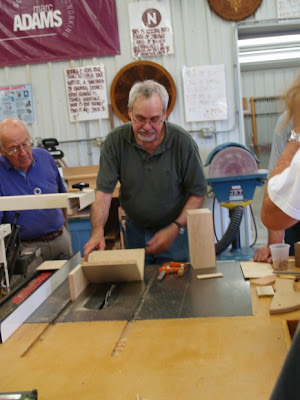

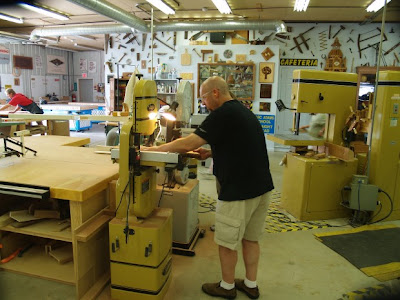

 Also teaching this week are Alf Sharp, a friend from Furniture Society whose work is shown at left and Stephen Proctor an artist with incredible technical knowledge and abilities with whom I've taught at Marc Adams School before. I look forward to a great week.
Also teaching this week are Alf Sharp, a friend from Furniture Society whose work is shown at left and Stephen Proctor an artist with incredible technical knowledge and abilities with whom I've taught at Marc Adams School before. I look forward to a great week.
Analogy is often used to help provide insight by comparing an unknown subject to one that is more familiar.I am poised at the edge. The car is nearly packed for my trip to Marc Adams School where I will teach Box Making for a week and then a day class of Mentoring Children in Woodworking. Unlike molecules rushing from space into a black hole, my trip to Marc's won't be over a falls, but into the stream of companionship with students who love woodworking.
Many of our founding fathers got their hands dirty:Joe, It is interesting how the David Pye equation of certainty vs. risk is played out on the night of the 4th. Light the fuse and run like heck before something blows up in your face or hands. Then if you are lucky to make it back to your seat unscathed, you are rewarded by beauty in lights and sound and the oohs and aahs as your peers revel in delight. Parents want everything to be safe and children grow through the taking of risks. The search for dizziness. To be safe is mind numbing. To dwell constantly in the state of risk is intolerable. So we seek balance, and note that those who were wise were active in head, heart and hand. Happy 4th. If something is about to blow up, set it down and run like heck.
Franklin was a printer/publisher
Washington was a farmer and distiller
Jefferson was a farmer
Sam Adams was a brewer..... (I believe I'll have another with that hamburger, please).
For those of us with a well-developed love of working with wood, sharing that love with others is a "no-brainer." It arises from our passion. Those who love children, whether their own or in their communities, may think that because children are quietly occupied with their hands-on video devices, they are in good hands and that your guidance and attention are not required. However, the evidence linking damage to children's attention to learning and capacity for learning to the amount of time spent watching television or engaged in computer gaming is strong. In fact, it is far stronger and more clearly documented than the evidence linking smoking to lung cancer and heart disease. In addition, there is a huge and growing amount of statistical data linking the effectiveness of learning and joy in learning to the engagement of the learner’s hands. So what's a woodworker to do? Isn't it obvious? But how do you get started? How can you keep your child safe? How can you encourage your child's confidence, creativity, and skill? Doug Stowe will help answer all these questions. He has been the director of a woodworking program at Clear Spring School in Northwest Arkansas for seven years and works with students of all ages. Articles about his program have been published in “Woodwork,” “Woodcraft,” “Cabinetmaker,” and on line at “Fine Woodworking” website. In addition to reaching woodworkers with this vital information (preaching to the choir), his articles have been published in “Independent School” and “Encounter” magazines.
This class is hands-on learning for adults with the purpose of providing an understanding of children's needs and the educational opportunities that woodworking can provide. Even more, this is about sharing with our kids, the most important part of our lives as creative and enthusiastic life-long learners.
Matti Bergström(1996) is a brain researcher. The brain stem, the cortex and the limbic system are the parts of the brain that correspond to play acting. The brain stem feeds chaotic impulses to the limbic system whereas the cortex stands for order. Bergström discusses play dominated by impulses from the brain stem (black play) and from the cortex (white play.) It is clear that Bergström's black play corresponds to Cailois' ilinx whereas white educational play mainly corresponds to competition and imitation. According to Bergström black play does not last long because the brain does not work for a long time without any kind of order.Ilynx is the sensation of dizziness and we all remember the need we had as children to ride the edge, losing the sense of control by spinning until the usual senses went awry. Kalliala points out that there are forms of mental dizziness as well as physical in which the balance between order and chaos are deliberately tested for amusement.
Searching for dizziness also occurs in an adult's life in the form of parachute jumps, slalom, rally racing or motor biking. Technical developments have expanded the role of ilinx by bringing to amusement parks different kinds of machines that allow people to experience increasing vertigo.

In order to experience academic achievement, students must possess inner qualities that enable them to perform academic work. Qualities such as concentration, attentiveness, patience, persistence, cooperation, responsibility and thoughtfulness are the foundations for academic achievement. No matter what new curriculum is composed or new educational configurations are devised, if children do not have the inner qualities that are essential for any academic success, they are doomed to fail.Woodworking anyone? It develops all those skills now lacking in American education.
Young people today are quick to feel frustrated and consequently intolerant of intellectual challenge. Their impatience makes them less willing to apply critical thinking to a difficult mathematics problem, savor the challenge of reading a complex novel, work through an intricate lab experiment or master the subtleties of grammar in English or a foreign language. Frustration curtails a young person's ability to listen, absorb, and process the details that constitute learning and knowledge.
Brain research confirms this phenomenon. Today children are raised in a culture that stunts the development of the qualities necessary for academic success. The Herculean challenge of schools is to reverse this trend.

consider how, in the long term, science, technology, engineering and mathematics research and development might be used to create modern design and technology projects, with mathematical and scientific content, to enable schools to keep pace with technological advancesI wonder how anyone can actually keep pace with the advances if they haven't begun with the basics. Kids tend to be much more easily proficient than adults in the use of new technology but have little or no curiosity to understand its inner works and processes. How can you feel competent in the areas of design and technology if you haven't had the actual experience of making things? How can you use materials effectively if you haven't explored their most subtle qualities?
 Getting kids started in woodworking is not rocket science. It is easy. I am reminded of when my wife brought home books on breast feeding, lots of them, and I wondered, how there could be so much to read about something that is so basic in human experience.
Getting kids started in woodworking is not rocket science. It is easy. I am reminded of when my wife brought home books on breast feeding, lots of them, and I wondered, how there could be so much to read about something that is so basic in human experience. Project Zero was started at Harvard to help guide the effort, but how many educators have even heard of it? When I was at the first International Conference on Sloyd, Traditions in Transition in Umeå, Sweden, one of the attendees asked me, "What university are you from?" "What would I learn there?" I asked in return. I told her I teach in an independent school where I learn about teaching by teaching and teach teachers by example.
Project Zero was started at Harvard to help guide the effort, but how many educators have even heard of it? When I was at the first International Conference on Sloyd, Traditions in Transition in Umeå, Sweden, one of the attendees asked me, "What university are you from?" "What would I learn there?" I asked in return. I told her I teach in an independent school where I learn about teaching by teaching and teach teachers by example.